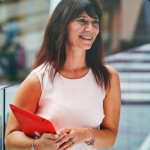 Tell us a bit about your career story so far.
Tell us a bit about your career story so far.
I trained as a therapeutic radiographer on a non-degree-based three-year diploma at the London Hospital in Whitechapel. I qualified and worked at the hospital for a very short time before moving up to the radiotherapy department at The Leeds Cancer Centre.
After about two years as a clinical radiographer I needed a new challenge so alongside that role I started my first degree, part-time. That was followed by a part-time master’s degree. All the while I was working my way quite quickly up through the NHS grades to the point where I was in quite a senior clinical role, leading a big team specialising in pre-treatment imaging.
I was always really bothered by things we did in clinical practice that I thought we could do better and by this time I had a bug for studying and learning and was really into research, so I started a doctorate – part-time, again – which was quite unusual for clinical radiographers at the time.
As I was writing up the PhD I applied for a senior lecturer job at Sheffield Hallam and moved here in December 2001, mainly because I wanted to continue doing research rather than a managerial role in the NHS.
Having been on quite a steep career trajectory, it did slow down for a few years as I got to grips with academia, balancing lots of teaching with trying to do research when I could. Then in 2013 I was successful in getting a reader post which was fantastic and allowed me to concentrate more on my research in breast cancer radiotherapy.
In 2015 I applied for professorship and was successful, and here I am. In 2020 I was appointed as director of the Health Research Institute.
What does it mean personally to you to be a professor at Sheffield Hallam? What do you value about it?
It gives me the opportunity to lead, inspire and support the next generation of clinical researchers. As a professor I feel it’s my role to lead in lots of ways, not just within the University but externally and for the future of my profession. It’s nice to be able to show others that people like me, who come from a clinical background, can lead big research projects.
If you could go back in time and give yourself some career advice, what would it be?
- Get a mentor. I struggled as a post-doc to work out where I should focus my research activity and how to balance developing an external profile, networks, and links with my teaching commitments.
- For those like me that have come from a clinical practitioner background, I would say use those clinical links to your benefit. Capitalise on your relationships with clinical colleagues to develop research teams and projects that can have real impact. Use those links to support dissemination of your research outcomes through CPD and training opportunities for clinical colleagues, enhancing the opportunity for wider impact from your research.
Tell us about your work as a professor?
I support MSc dissertation students and doctoral students. I run a network for clinical practitioners that specialise in breast cancer radiotherapy (The Breast Radiotherapy Interest Group-BRIG) that has over 100 members from the UK and globally.
That’s combined with the research projects I work on, such as the Support 4 All Project where we’re developing a support bra for women who undergo breast radiotherapy.
Another is the Respire Project. One of the risks with breast radiotherapy is irradiating the heart, which can cause problems in later life. A deep inspiration breath hold (DIBH) is a technique where the patient takes a deep breath and holds it, which moves the heart out of the way. The problem is it’s quite a challenging technique, especially when a patient is nervous and lying on a hard bed. So we’ve co-designed some online resources with patients and physiotherapy colleagues to guide patients through the whole radiotherapy process and coach them on DIBH so they can practice at home. It’s just a simple thing but it reduces patient anxiety and helps them carry out the technique, and we know it has real impact because we get messages from practitioners about how it’s helped their patients.
My research institute director role has given me the opportunity to do something really positive to raise the profile of health research and support people in development to become research leaders, which is a huge passion of mine.
Externally, I do a lot of work with the College of Radiographers. I was chair of their research group and co-wrote their five year research strategy. That strategy has helped embed research in a clinical setting and promote the impact of radiographers working in research.